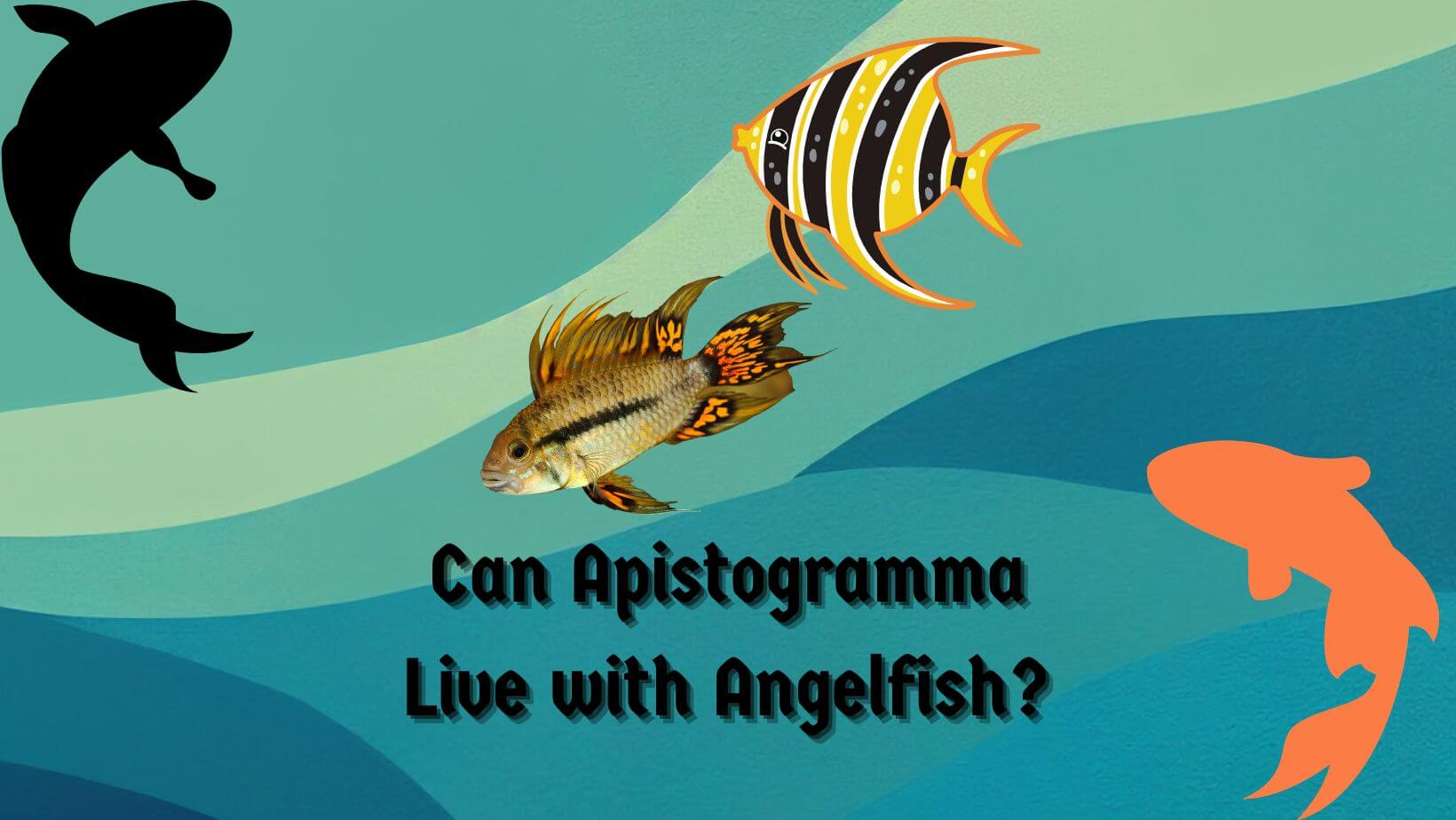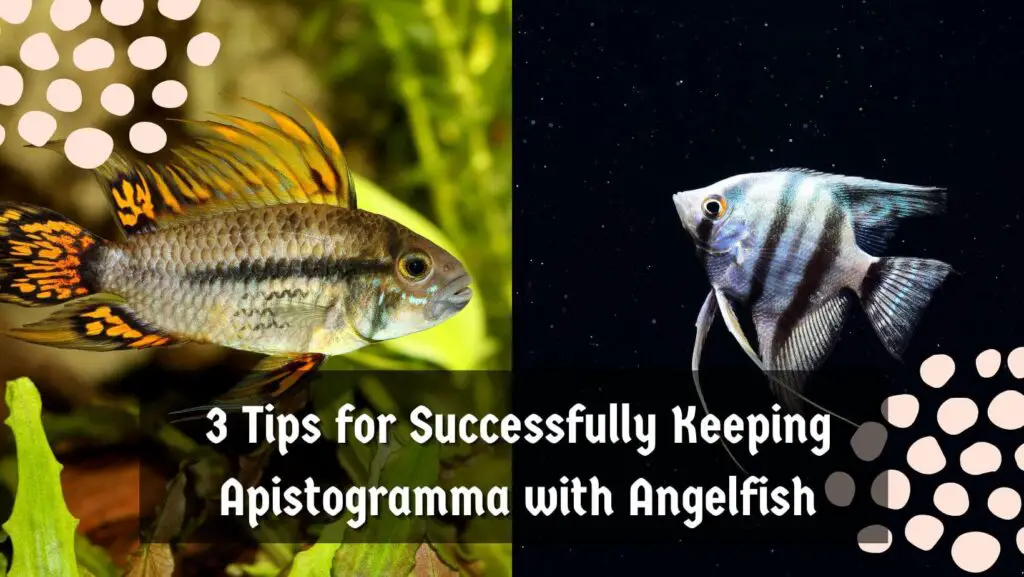
Who will not love a vibrant aquarium filled with a captivating mix of Apistogramma and Angelfish gracefully swimming side by side? But before you try to create this aquatic masterpiece, you might wonder, can Apistogramma live with Angelfish?
Welcome, my; you have come to the right place because this comprehensive guide will help you delve into the fascinating world of these two fish species and explore their compatibility.
We will also discuss the factors and practical tips that may influence or ensure harmonious cohabitation in your aquarium. But before I tell you what factors may affect the compatibility between these two species, it is important that you first know: can Angelfish live with Apistogramma?
Can Angelfish Live With Apistogramma?

Yes, Angelfish and Apistogramma can live together. Angelfish will mostly occupy the upper region in tank settings, while apistos will stay low. However, the degree of compatibility may be influenced by factors like water parameters, tank size, behavior, environmental commonalities, and habitat overlap when housed together.
Apistogramma, often called “dwarf cichlids,” are a diverse group of colorful freshwater fish. Angelfish are true marvels of the aquarium world with their graceful presence & distinctive triangular shape.
There are currently more than 90 recognized species of Apistogramma, and they offer a captivating array of sizes, colors, & behaviors. For instance, you can find species like Apistogramma cacatuoides, commonly known as the Cockatoo cichlid, which boasts vibrant hues of orange, yellow, & blue.
On the other hand, if you look at the most commonly kept angelfish species, you will find Pterophyllum scalare also showcasing a regal beauty with its long, flowing fins and various color variations.
Apistogramma originates from the Amazon River basin and is particularly known for its intriguing social structure, including complex mating rituals & hierarchical behavior (similar to Angelfish’s hierarchical behavior) within their communities.
Originating from the freshwater rivers of South America, Angelfish possess a social structure similar to that of Apistogramma with well-defined territories. Now that I have properly understood each species, you should know what factors may determine compatibility if kept in the same tank.
Natural Habitat Overlap
As per wikipedia also, both the species, Apistogramma & Angelfish, hail from the Amazon basin, which already creates an overlap in their natural habitat requirements. You can comfortably keep them in equal water parameters because both species are known to thrive in warm temperatures with a similar pH level changing from slightly acidic to neutral.
Also, provide dense vegetation inside their large tank with plenty of hiding spots like driftwood or rocks for their well-being. If both species share the same environmental aspects, provide a conducive space for both species. Also, make sure to provide them with a diet of their own.
| Parameters | Apistogramma | Angelfish |
| Water Temperature | 75-82°F (24-28°C) | 75-82°F (24-28°C) |
| pH Level | 6.0-7.5 | 6.0-7.5 |
| Hardness | Soft to Moderately Hard | Soft to Moderately Hard |
Size & Aggression Considerations
There are a few things that you need to consider when keeping both species together in the same tank, like size disparities which can significantly influence their compatibility as well. This size difference can lead to potential aggression issues since Angelfish tends to be larger than most Apostogramma species.
Generally, Angelfish are not very aggressive, and to know more about their aggression, consider reading my article: are Angelfish Aggressive? To ensure a harmonious tank, select an Apistogramma species that are not significantly smaller than the Angelfish. It is best to choose Apistogramma species like A. cacatuoides which can reach up to 3 inches in size, further helping you balance the size dynamic within the aquarium.
Tank Size & Layout
Now, you must create a welcoming space for all your companions living in the aquarium. If you want to foster peaceful cohabitation, choose a larger tank with ample space and a suitable hiding spot.
Large tanks will minimize territorial disputes as each species & fish will get a chance to establish its territory. I recommend using at least a 30-gallon tank size for a harmonious mix of Apistogramma and Angelfish.
Do decorate it with plants, driftwood, and rocks, essential to provide hiding spots and mimic the natural habitat to reduce stress & promote overall well-being.
- Some Related Posts Worth Checking
- Can Angelfish Live With Tetras?
- Can Angelfish Live With Gourami?
- Can Angelfish Live With Bettas?
3 Tips for Successfully Keeping Apistogramma with Angelfish

I hope I have covered every compatible aspect you need to know: can Apistogramma with Angelfish? Now, it’s time to explore some practical tips that can ensure both species’ successful cohabitation in your aquarium and promote a harmonious environment.
Smooth Transitions
If you want to introduce new fish to the tank, follow a gradual acclimation process. You first need to quarantine any new species or addition to prevent the spread of disease. This will ensure their overall health before introducing them to the main tank.
I usually slowly acclimate the new fish to the tank water parameter over several hours to minimize the risk. If you also want to avoid any stress or shock to your new pet, follow this approach.
Catering to Dietary Needs
Apistogramma and Angelfish have varying dietary requirements, and you must provide a well-balanced diet for both species. Apistogramma is primarily omnivorous and usually benefits from a diet of high-quality pellets and live or frozen foods.
Occasionally, they can eat vegetable matter as well. On the other hand, Angelfish are primarily carnivorous (but not strictly carnivorous); to know more, read: ‘Do angelfish eat other fish,’ ‘are Angelfish aggressive’ or ‘do Angelfish eat algae.’ They thrive on high-protein flakes, pellets, and live or frozen foods.
Monitoring Tank Dynamics
Another place where you need to pay attention is to regularly observe the behavior of your fish to identify any compatibility issues or signs of stress. Act promptly if your fish is excessively hiding or running one after another.
It is important to address any conflict as soon as possible by providing additional hiding spots or rehoming a fish to a separate tank if necessary. Also, you must pay attention to both species’ health and well-being by maintaining optimal water quality.
Make sure to do regular water changes & install proper filtration. Remove uneaten food and debris as well to maintain pristine water conditions. It is better to test the water parameters periodically to ensure all fishes remain healthy within the suitable range & water parameters.
Conclusion
I have given my best to give you in-depth insight and understanding of Apistogramma and angelfish compatibility. If you have any other concerns regarding the question: can Apistogramma live with Angelfish? Drop a comment below.
If you implement the right strategies and understand compatibility factors, you can create a thriving aquarium with a captivating mix of Apistogramma and Angelfish species. Consider size disparities and maintain suitable water parameters for both species.
With proper care & attention, you can enjoy the beauty and charm of these two fish species coexisting harmoniously in your aquatic heaven. Males will provide hiding spots and ample space and monitor their behavior.
I hope you find this article helpful where you got to learn: can Apistogramma Live with Angelfish? If you find this article helpful, then consider sharing it. Your share will help people learn about the compatibility of Apistogramma & Angelfish together, coexisting in the same environment or tank. Check my other helpful guide on angelfish care and FAQ on this website. See you in the next post, till then, take care & goodbye.
By understanding the compatibility factors and implementing the right strategies, you can create a thriving aquarium with a captivating mix of Apistogramma and Angelfish. Remember to consider size disparities, maintain suitable water parameters, provide ample space and hiding spots, and monitor the behavior of your fish.
You can enjoy the beauty and charm of these two fish species coexisting harmoniously in your aquatic haven with proper care and attention. As you embark on this exciting journey, remember to consult reputable sources, seek advice from experienced aquarists, and conduct further research to ensure the well-being of your fish.